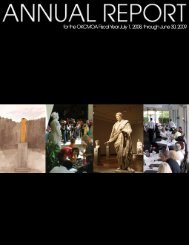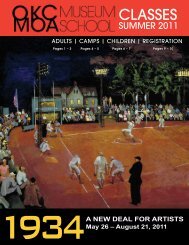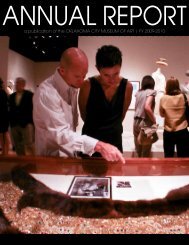Roman Art from the Louvre Educators' Resource Guide
Roman Art from the Louvre Educators' Resource Guide
Roman Art from the Louvre Educators' Resource Guide
You also want an ePaper? Increase the reach of your titles
YUMPU automatically turns print PDFs into web optimized ePapers that Google loves.
7<br />
or princeps senatus, while changing his name in 27 B.C. <strong>from</strong> Gaius Julius<br />
Caesar Octavianus to Augustus (meaning “exalted”).<br />
Augustus did not make any great governmental changes <strong>from</strong> <strong>the</strong> republic,<br />
which had collapsed only decades before. He maintained institutions such<br />
as citizens’ assemblies and <strong>the</strong> senate (though only as an advisory body),<br />
which he, and all subsequent emperors, controlled, nominating all new<br />
senators and purging incumbents at will. He often relied on his own circle<br />
of friends and patrons for political advice and support ra<strong>the</strong>r than <strong>the</strong> senate.<br />
As <strong>the</strong> central authority, <strong>the</strong> emperor made all laws and was <strong>the</strong> main<br />
judicial source, controlling domestic and foreign policy, as well as <strong>the</strong> state<br />
economy. He served as commander and chief for <strong>the</strong> military and was <strong>the</strong><br />
person who most shaped <strong>Roman</strong> society. He presented himself as <strong>the</strong> savior<br />
and guardian of Rome, and many of <strong>the</strong> emperors were proclaimed Pater<br />
Patriae, Fa<strong>the</strong>r of <strong>the</strong> Fa<strong>the</strong>rland, one of a number of imperial titles often<br />
used that also included Caesar, Augustus, and Imperator.<br />
The emperor also controlled <strong>Roman</strong> religion. As chief priest, <strong>the</strong> emperor<br />
presided over <strong>the</strong> detailed ceremonies and practices that defined imperial<br />
religion and was responsible for settling any religious disputes. Although<br />
mortal, <strong>the</strong> emperor traced his heritage back to Venus, <strong>the</strong> <strong>Roman</strong> goddess<br />
of love and beauty. Every <strong>Roman</strong> had to honor <strong>the</strong> emperor, and a number of<br />
imperial cults arose as a result. Like eastern rulers, <strong>the</strong> emperors had great<br />
influence over <strong>the</strong> culture of <strong>the</strong>ir empire. They adorned public buildings<br />
with works of art <strong>from</strong> all over <strong>the</strong> empire, opened libraries near temples,<br />
and built immense palaces. Public architecture experienced an escalation<br />
in scale toward <strong>the</strong> truly colossal, as demonstrated by <strong>the</strong> basilica in <strong>the</strong><br />
forum of Carthage and <strong>the</strong> basilica of Maxentius in Rome. After <strong>the</strong>ir deaths,<br />
worthy emperors and <strong>the</strong>ir wives were elevated to divinities and could be<br />
represented with <strong>the</strong> attributes of gods and goddesses. Emperors who fell<br />
out of favor, such as Nero, Domitian, and Commodus, however, were not deified.<br />
Their memories were officially damned and <strong>the</strong>ir images and names<br />
erased <strong>from</strong> coins, sculpted portraits, and monuments.<br />
With no clear rules in place, <strong>the</strong> issue of succession was quite complex.<br />
Many emperors ei<strong>the</strong>r identified a new leader <strong>from</strong> within <strong>the</strong>ir own families<br />
(if an appropriate heir existed) or chose a qualified male <strong>from</strong> <strong>the</strong> upper<br />
class whom <strong>the</strong>y would <strong>the</strong>n adopt in order to create a familial relationship.<br />
With such loose rules and large royal families—many <strong>Roman</strong> emperors had<br />
children <strong>from</strong> multiple marriages—it is not surprising that competition for<br />
<strong>the</strong> throne existed among royal family members. Many even resorted to<br />
violence to ensure succession or remain in power once elected. In <strong>the</strong> mid-
















